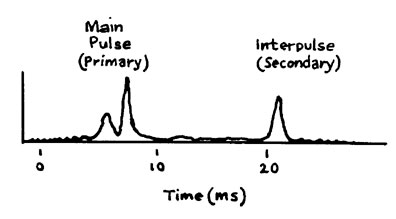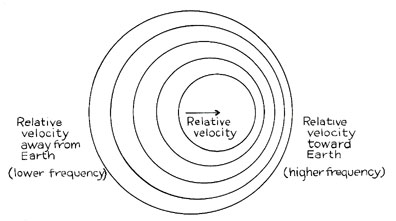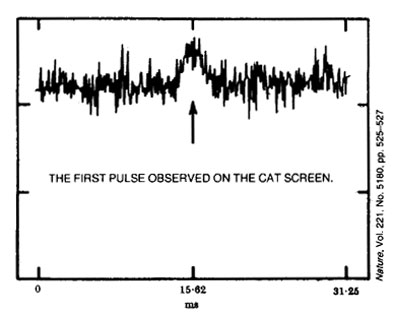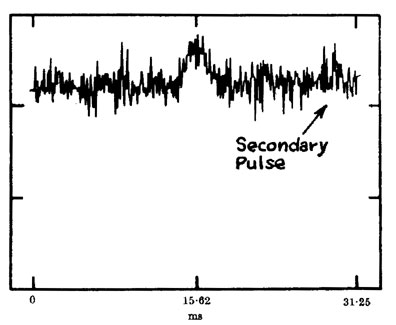
COCKE: The Crab pulsar has two pulses in it—a big one, the primary one, and a shorter, fatter, secondary pulse. They come more or less spaced evenly between each other. The radio pulse looks like that, and so we had felt probably that's what the optical pulse would look like too.
DISNEY: Well, for a few moments we were quite excited because we really thought that Baade's Star would be the place to find this pulsar. And, in fact, there was no sign of a pulsar at all, so we were all a little bit let down. And Don decided that he had to go back to the University in Tucson. So, the next day he showed us how to work all the equipment. By now we were pretty familiar with it and realized it really wasn't as terrifying as it all looked at first. And so on the third night, John and I observed on our own. We weren't exactly on our own at all, in fact, we had Bob McCallister, you know, prevented us from making a lot of mistakes, and was actually working some of the electronic equipment for us. We repeated essentially what we had done the previous night, and we didn't find any pulsar at all.
COCKE: I do remember feeling pretty discouraged about the whole thing. Of course, we weren't very optimistic to begin with—or at least, I wasn't. And so, I wasn't feeling as discouraged as I would have if I'd had really high hopes.
DISNEY: We had two more nights to go, and then it turned out they were both cloudy, so there was nothing we could do anyway. And then it just happened. The person who was observing after us—Bill Tifft, his name was—he said that his wife was sick and he couldn't come observing—there were a couple of more days we could have. So we decided well, anyway, we might as well use them.
COCKE: The next two days then were spent more or less walking around the mountain under the clouds, trying to think what to do next. Until then I remembered that it would probably be a good thing to go and re-check the calculations that I did.
DISNEY: And when I came up the mountain in the evening of the next day, John and I cooked dinner and he told me something very interesting. Because the earth is moving around the sun, the actual period—the apparent period—of these pulses from the pulsar changes as the earth is moving either towards the pulsar or away from it. When the earth is moving towards the pulsar, the pulse is going to appear to come more quickly than they would normally. And when we're moving away, they'd rather come more slowly. It's like a train coming towards you. The note drops, it's what's called the Doppler effect. And so we'd had to make corrections to the known period, the radio period of the pulse.

And John said, "Look," he said, "we made a mistake doing this." And so we sat down over the kitchen table in the Observatory and spent an hour going over all these calculations again. And, by Jove, that's exactly what we had done—we'd made an error in making this correction. So we hadn't really looked for the pulsar at all because our timing gear had been set at the wrong period.
COCKE: It
was an error of 2 ![]() ,
actually. I had mistakenly approximated the sine of an angle by the angle
divided by 2
,
actually. I had mistakenly approximated the sine of an angle by the angle
divided by 2 ![]() .
Well, I felt like a real idiot. And I was a bit dumbfounded, because now,
having gone through all that time to make these observations, now I was
faced with the prospect of having to go back and do the whole darned thing
over again—again with the feeling that it was utterly futile anyway,
and that, really, the whole thing was a waste of time.
.
Well, I felt like a real idiot. And I was a bit dumbfounded, because now,
having gone through all that time to make these observations, now I was
faced with the prospect of having to go back and do the whole darned thing
over again—again with the feeling that it was utterly futile anyway,
and that, really, the whole thing was a waste of time.
DISNEY: So Bob McCallister, the night assistant, John Cocke and I went up into the dome, reset the timing gear at the new period that we'd worked out, and then we sat back to go right through the whole procedure again starting to look at Baade's Star, the South Preceding star.
On the night of January 15, 1969—at Steward Observatory—John Cocke, Michael Disney and Bob McCallister adjusted the timing gear and set the 36-inch telescope on Baade's Star. They were unaware that while they were observing, they were also tape recording their own voices. On this part of the audio, you will hear portions of that candid recording as well as more excerpts from the interviews with John Cocke and Michael Disney and closing remarks by Philip Morrison.
DISNEY: We all crouched in front of the telescope, or at least in front of the electronics, because the telescope runs itself once you've set it correctly. We all crouched in front of the electronics looking at this little screen, watching these green dot coming up the middle.
MC CALLISTER: This next observation will be observation number 18.
DISNEY: We've got a bleeding pulse here.
COCKE: Hey. Wow, you don't suppose that's really it, do you? Can't be.
DISNEY: It's right bang in the middle of the period, look. I mean, right bang in the middle of the scale. It really looks something from here at the moment.

COCKE: Hmm!
DISNEY: It's growing, too. It's growing up the side a bit, too!
COCKE: God, it is, isn't it. Hmm!
DISNEY: Good God, you know that looks like a bleeding pulse.
{laughter)
It's growing, John.
MC CALLISTER: It is.
DISNEY: Look.
MC CALLISTER: It is. Hey, you're right.
COCKE: We saw the pulse come up almost immediately. And we were both—both Disney and I—were completely dumbfounded by the whole thing.
DISNEY: I shan't ever forget that, because it was right in the middle of the screen. It seemed—on the very first run that we made with this new timing—it seemed, well, it just seemed incredible. And I can remember crouching in front of it and my eyes popping out on stalks, and saying, "My God, there's a bleeding pulsar out there." And John was swearing to himself, and Bob McCallister was, I don't know quite what he made of it. None of us really believed it.
COCKE: God, I hate to believe it right now, though.
(laughter)
Well, we're up to 2,000 counts. We're now at 750, 700.
(inaudible)
DISNEY: It's really building up. Look at that.
COCKE: It is, isn't it. Yeah.
DISNEY: There's not one left behind now. See, look, not one of those dots left behind.
COCKE: By God, yeah, uh huh.
(crosstalk)

DISNEY: There's a second something over here.
COCKE: Well, we expect two: a small pulse and a larger pulse, remember?
DISNEY: Uh huh. Right. I wasn't too sure of this one, but—.
That's a bleeding pulse.
COCKE: It is, isn't it. God. I don't believe it.
(laughter)
DISNEY: I don't believe it—I won't believe it until we get a second one.
COCKE: I won't believe it until we get the second one and until the thing has shifted somewhere else.
DISNEY: God, just come and look at it down here.
(laughter)
This is an historic moment. Hmm!
COCKE: I hope it's an historic moment. We'll know when we take another reading. And, if that spike there is again right in the middle—that spike is right in the middle and that scares me.
